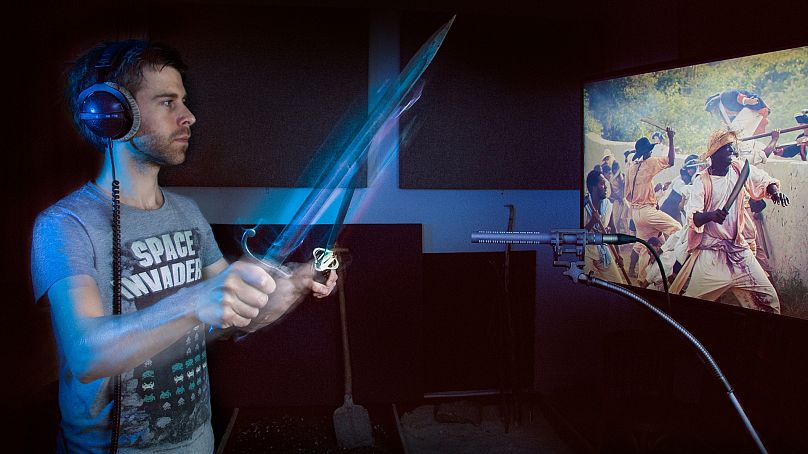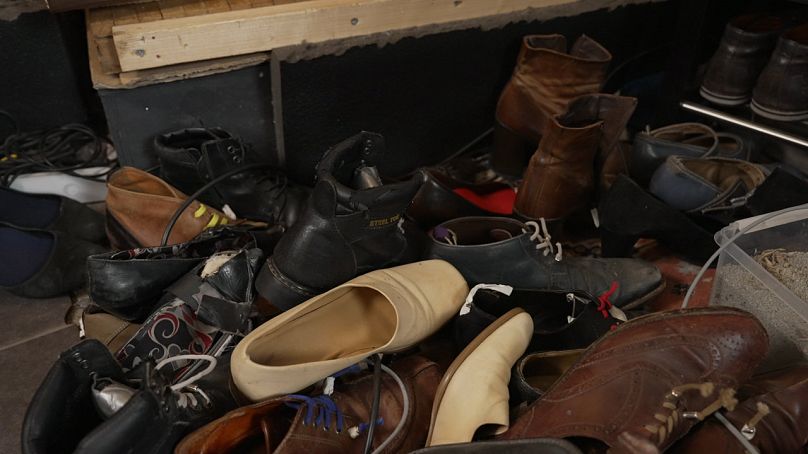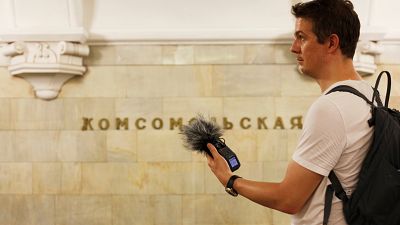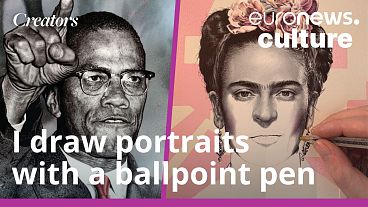Unsung heroes of the movie industry, Foley artists create much of the sound heard in films and TV shows. A Dutch artist shows us how it’s done.
If Ronnie Van der Veer does his job well, his work will be nearly imperceptible. It’s what every Foley artist aspires to – making the audience forget that much of the sound in a movie is added afterwards.
Foley technique is named after the American sound effects pioneer Jack Foley (1891-1976) who developed unique methods in synchronisation with picture and post-production.
“Sound works very unconsciously in a movie,” Van der Veer told Euronews Culture. “That’s what I really like about it. We create all kinds of little details that make you feel closer to the characters, make you feel more in the scene. Even though people don’t realise it’s created by us and not by the actor, it’s still a very valuable addition to the movie experience.”
From his studio in Haarlem, just outside Amsterdam, Van der Veer has created sound effects – or Foley – for films and TV shows like Yorgos Lanthimos’ The Lobster, Dutch war film The Forgotten Battle, and Netflix Original series “Love & Anarchy”.
He’s made sounds for huge battle scenes, anxiety-inducing horror films, nature documentaries and everyday human interactions between characters. He’s even created sounds for make-believe creatures like dragons too.
Van der Veer says Foley comes down to striking a balance between realistic, believable sounds and over-the-top movie magic.
“Very often we try to recreate reality by adding details, so you feel like what you’re hearing is really connected to what you’re seeing,” he explained. “It could be exactly that shoe on that surface in that specific room with that reverb. But we’re also making a movie, so sometimes we’re trying to make something that’s bigger than life.”
For example, in real life, guns don’t rattle: “That would mean your gun is broken, right? But in films, it’s a movie cliche that when someone grabs a gun, it rattles a bit. Or when a soldier is running with a rifle, it will rattle a bit as well.”
One of the most fun parts of his job, Van der Veer says, is creating a presence for things that don’t normally make a sound.
“When an ant is walking on a leaf, in reality you don’t hear it,” he says. “But when it’s a very close-up shot, we need to make those footsteps. And the ant is maybe eating something, so suddenly I’m eating something to create the sound of the ant eating something. That’s very funny, because in real life you would never hear that.”
How Foley sounds are created
The first step of making Foley, according to Van der Veer, is watching the source material.
“Normally I would always watch the movie first to have an idea of if I need to get any props I don’t have in the studio,” he says. “I’ll talk to the sound designer to see what’s the style of the movie. I ask if there are any specific sounds that are important, that the director maybe wants to hear.”
Van der Veer’s studio is chock full of props – stored in different containers with labels, hanging from the walls. He has different types of floors for different situations. He has more shoes than you can possibly imagine. He even has a small car he uses for scenes that take place inside vehicles.
“It might look like an exploded thrift shop or something, but I actually know where everything is.”
After gathering all the props he needs, the recording begins. Van der Veer will play the source material and begin to act out the sounds in each scene.
“We use a lot of layering in the recording process,” Van der Veer says. “So in a scene where someone is walking with a bag, we would first do the footsteps and then we do the rattling of the bag. We’d do a take also with the clothes rustling. Maybe someone’s wearing jewellery, so that’s also something we would record. It’s nice also for the sound designer to have that separately.”
Van der Veer almost always works with a sound engineer, who records and can change the mix to add nuance to the finished product.
“The Foley mixer I work with could make a perspective change in the sound,” he explains. “So when someone is walking from further away, closer to the camera, he can change the mix of the microphones to create that effect, which sounds very natural.”
Sound as a vehicle for emotion
Van der Veer says he prefers to record the sound of a film chronologically because it helps him experience the film the same way the audience would.
“Normally, we watch the first scene and we do all the sounds for that scene and then we move on to the next scene,” he explains. “What I like about that process is that we kind of go on the same journey as the viewer and the characters. So maybe, halfway through the movie you might decide to change the shoes, for instance, because the character has more confidence or walks in a different way.”
Footsteps are some of the most common and complex sounds that Foley artists are asked to create. After finding the right shoe and the right floor for the scene, Van der Veer says he also has to get into the skin of the character to get the sound exactly right.
“There’s a reason why you cannot use (pre-recorded) sound effects for footsteps, because every character walks in a different way,” he says. “Even in the same scene, someone might be in a different emotional state and so they’ll walk in a different way. The camera might be further away or suddenly very close. All those things we incorporate into the recording of the Foley.”
“It’s a very human thing. Sometimes they call us actors of sound, because like an actor we also play with emotion.”
Working so intimately with sound has made him see the world differently, Van der Veer says. He’s more in tune to the sounds around him in everyday life – while sitting in his garden, for example, he’ll hear all the small sounds around him made by the wind, the birds, the insects.
When shopping for props at second-hand stores (used items sound better, he says), he often chooses objects not by their practical use, but their sonic potential.
“It’s happened in the past that I’ll be sitting on a chair in someone’s house and be like, ‘Hey can I buy this chair?’ Because it has such a good squeak,” he said.
“There are chairs in the studio that I got in this way, because they had a very nice squeak and people didn’t mind getting a new one. It’s very hard to shut off, because it’s something I’m aware of all the time, all the sounds around us.”
To see for yourself how Foley is created, watch the full episode of Creators in the player above.





